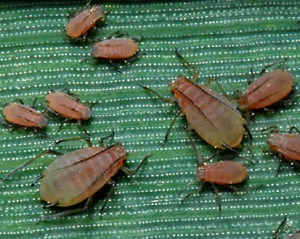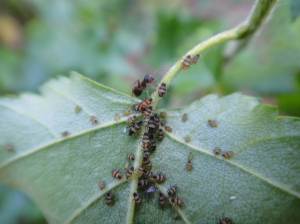There is a common misconception aided and abetted by their common name of greenfly and blackfly, that aphids are either green or black. Although many aphids are indeed green, many are other colours. In fact, it is possible, with a little imagination, to construct an aphid rainbow.
What I find even more interesting is the fact that some aphid species exist in more than one colour form (morph). The pea aphid for example, has green and pink clones, Myzus persicae (the peach-potato aphid) can be green or red, the rose aphid, Macrosiphum rosae, pink, brown or green.
 The grain aphid, Sitobion avenae, is even more versatile, and can be light green, dark green, brown, pink and also a sort of mottled green-brown. Even more interesting, green S. avenae can give birth to brown offspring and brown to green.
The grain aphid, Sitobion avenae, is even more versatile, and can be light green, dark green, brown, pink and also a sort of mottled green-brown. Even more interesting, green S. avenae can give birth to brown offspring and brown to green.
Perhaps one of my favourites is the small willow aphid, Aphis farinosa, where green mothers give birth to orange offspring which are clearly visible within their mothers before birth.
Although this aphid striped like an Everton mint is quite fun too.
Why some aphids have different colour morphs is not really understood, although some authors have hypothesised that it may be a response to high temperature (Dixon, 1972) or an adaptation to avoid parasitism and predation (Ankersmit et al., 1981; Losey et al., 1997). The pigments are in the haemolymph and may be controlled by some of the endosymbiotic bacteria that help aphids rule the world (Jenkins et al., 1999).
As a further point of interest, some of the pigments produced are almost like dyes. If, for example, you squash a giant willow aphid, Tuberlocahnus salignus, not only will it stain your fingers bright orange, if you then wipe your fingers on your clothes they will be stained permanently. Luckily, your fingers will return to their normal colour in a day or two.
References
Ankersmit, G. W., Acreman, T. M., & Dijkman, H. (1981). Parasitism of colour forms in Sitobion avenae. Entomologia experimentalis et applicata 29: 362-363.
Dixon, A. F. G. (1972). Control and significance of the seasonal development of colour forms in the sycamore aphid, Drepanoisphum platanoides. Journal of Animal Ecology 41: 689-697.
Jenkins, R.L., Loxdale, H.D., Brookes, C.P. & Dixon, A.F.G. (1999) The major carotenoid pigments of the grain aphid Sitobion avenae (F.) (Hemiptera: Aphididae). Physiological Entomology, 24, 171-178. http://onlinelibrary.wiley.com/doi/10.1046/j.1365-3032.1999.00128.x/pdf
Losey, J. E., Ives, A. R., Harmon, J., Ballantyne, F. &Brown, C. (1997). A polymorphism maintained by opposite patterns of parasitism and predation. Nature 388: 269-272. http://www.nature.com/nature/journal/v388/n6639/full/388269a0.html
Post script
I have just received my latest copy of Antenna, the house magazine of the Royal Entomological Society and was vey pleased to find an article about aphid colours. Definitely worth reading if you can get hold of a copy.
Dransfield, R.D. & Brightwell, R. (2015) Colour in aphids – aposematic, cryptic or both? Antenna, 39: 60-71





Would you be able to hazard a guess about powdery (though quite dark) blue aphids densely packed on stems of Spanish Broom from March onwards? Sorry have no photos.
LikeLike
probably Aphis cytisorum also known as Aphis laburnum
LikeLike
Pingback: Ten facts about aphids › Expiscor
Pingback: Not all aphids have the same internal biomes | Don't Forget the Roundabouts
Pingback: Not all aphids are farmed by ants | Don't Forget the Roundabouts
Pingback: On rarity, apparency and the indisputable fact that most aphids are not pests | Don't Forget the Roundabouts